A Course in Public Economics:
Resources for Instructors
John Leach
August 2002
�
�
Course Design
Overview
A review of the contents and methodology of each chapter follows. The number in the middle
column is an estimate of the chapters difculty, on a 15 scale with 1 being the easiest. For
this purpose, I have imagined the students to be in their third or fourth year, with one or two
terms of Varian-style intermediate microeconomics, and with a grasp of basic calculus but
little exposure to statistics.
1:
Introduction
2: The Exchange
Economy
3: An Algebraic
Exchange
Economy
1 Discusses the two fundamental theorems of welfare economics.
Informally states the requirements of the rst theorem, and de-
scribes the market failures that arise when these requirements are
not satised: public goods, externalities, imperfect competition.
Introduces the concept of asymmetric information, and discusses
its relevance to the rst theorem. Argues that asymmetric infor-
mation precludes the government from transferring income in a
lump sum fashion, so that the requirements of the second theo-
rem are also unlikely to be satised. This chapter are entirely
verbal.
2 Introduces the concept of Pareto optimality and illustrates it with
a simple example. Develops the Edgeworth box, and uses it
to discuss Pareto optimality and competitive equilibrium within
the context of an exchange economy with two people and two
goods. Demonstrates the two theorems for this economy. The
arguments are verbal and graphical.
2 Constructs an algebraic version of the two person, two good ex-
change economy. Describes Pareto optimal allocations as so-
lutions to an under-determined equation system and presents a
Cobb-Douglas example. Describes competitive equilibrium as
the solution to an equation system and presents a Cobb-Douglas
example. Demonstrates the two theorems by comparing the two
equation systems.
�
4
4: The Production
Economy
5: Consumer
and Producer
Surplus
6: Externalities
and Negotiation
Course Design
3 Develops a two person, two good economy in which the people
are endowed with two factors of production and the ownership of
rms, but not with consumer goods. Describes a Pareto optimal
allocation as one satisfying three efciency conditions, and dis-
cusses each efciency condition. Shows that a Pareto optimal al-
location can be represented as a solution to an under-determined
equation system. Describes competitive equilibrium, and shows
that it can also be thought of as the solution to an equation sys-
tem. Presents an example of competitive equilibrium involving
simple functional forms. Demonstrates the rst theorem by com-
paring the equation systems.
2 Shows that the increase in total cost when output rises can be
measured by an area under the marginal cost curve. Presents a
more general rule of the relationship between margins and to-
tals.
Introduces consumer and producer surplus, and uses the
general rule to measure them. Argues that a system of free mar-
kets maximizes surplus, and that interventions cause a loss of
surplus, this being the interventions welfare cost. Examines the
welfare cost of a quantity constraint, and argues that the welfare
cost measures the value of the mutually benecial trades that are
prevented by the intervention. Introduces taxes and subsidies,
and shows that these interventions involve a transfer of surplus
between the government and the private sector. Shows that both
interventions reduce surplus: the welfare cost of the tax arises
because mutually benecial trades are discouraged; and the wel-
fare cost of the subsidy arises because trades that are not mu-
tually benecial are encouraged. Discusses the measurement of
the welfare cost of a tax when there is more than one tax. Pri-
marily verbal and graphical, but there is some algebra.
1 Discusses the problem of externalities. Presents the results com-
monly known as the Coase Theorem: if the parties affected by
an externality successfully negotiate, they reach an efcient out-
come under either assignment of the property rights; the assign-
ment of the property rights affects the distribution of income but
has no efciency implications. The reasons why negotiations
might fail are then explained, and the government policies that
could correct an externality are discussed. The Pigouvian tax is
introduced. The arguments are predominantly verbal and graph-
ical.
�
Overview
7: Permit Trading
8: Renewable
Common
Property
Resources
9: Co-ordination
Failures
10: Pure Public
Goods
5
3 Presents a model in which two rms have different abatement
costs. Calculates the resource cost of abatement under propor-
tional emissions reductions. Introduces the idea of tradable per-
mits, and derives the equilibrium price of permits. Shows that
the resource cost of abatement is smaller under permit trading
than under proportional reductions. The arguments are predom-
inantly algebraic.
3 Sets up a static model of the shery under competition and man-
agement. Shows that the competitive outcome is inefcient, and
identies the negative externality that causes this result. Shows
that the externality can be corrected by a Pigouvian tax. A dy-
namic model of the shery is then developed, and the depletion
of the shery under competition is demonstrated. Alternative
management regimes are described. The possibility of extinc-
tion is briey discussed. The models are both algebraic and
graphical. The dynamic model introduces the idea of a differ-
ence equation (but not its solution).
3 Identies situations in which each agents actions have positive
external effects on the welfare of the other agents. Introduces
the idea of a strategic game, and sets up a co-ordination game in
which each of two rms chooses between two actions (produce
and dont produce). Shows that the game can be represented
by a two-by-two table. Introduces the idea of a Nash equilib-
rium, and demonstrates that the game has two Nash equilibria,
and that both rms prefer one Nash equilibrium to the other. De-
velops a variant of the game involving uncertainty: each rms
production cost is an independent draw from a uniform distri-
bution. Shows that there is a Nash equilibrium in which each
rm produces only when its costs are sufciently low. Shows
that the Nash equilibrium is unique and inefcient. The game
with certainty is simple. The game with uncertainty involves the
calculation of a number of expected values.
2 Introduces the concept of a pure public good. Graphically
derives the Pareto optimal allocation for a two person econ-
omy with one private good and one public good, and discusses
the Samuelson condition. Develops the voluntary contributions
model for public goods provision, and nds the Nash equilib-
rium for the two person game.
Invokes symmetry to nd the
Nash equilibrium in the n person game. Compares the Pareto
optimal provision of a public good with its provision under vol-
untary contributions, and discusses free riding. The latter part of
the chapter is predominantly algebraic.
�
6
11: Two Examples
of Pure
Public Goods
12: Impure Public
Goods
13: The Link
Between
Public Goods
and
Externalities
Course Design
3 The rst section identies knowledge as a public good and ar-
gues that too little of societys resources will be allocated to its
provision. Corrective government policies are discussed, with
an emphasis on the effects of patents. The arguments are en-
tirely verbal. The second section presents a model in which the
wealthy care about their own incomes and the incomes of the
poor. It is shown that some income distributions are Pareto op-
timal and that some are not. A game in which wealthy peo-
ple choose their charitable contributions is developed, and it
is shown that the contributions of the wealthy are never large
enough to shift the economy to a Pareto optimal income distri-
bution: each wealthy person (and each poor person) would be
better off if every wealthy person contributed a little more. It
is then shown that charity has the properties of a pure public
good, and that the insufciency of the charitable contributions
is another manifestation of the free rider problem. This game
is more complicated and involves more extended reasoning that
the games presented in the earlier chapters.
4 Discusses two simple forms of impure public good. A club good
is assumed to be congestible, replicable and excludable. The op-
timal size and membership of a club good are characterized. A
variable-use public good is assumed to be congestible and non-
replicable. The particular case of a highway is discussed. The
optimal capacity of the highway in the absence of tolls is cal-
culated. The optimal capacity in the presence of tolls is also
calculated. The optimal toll is shown to be the Pigouvian tax.
The arguments are predominantly algebraic.
4 Argues that an essential feature of both public goods and ex-
ternalities is the interdependence of preferences. Develops the
Shibata box diagram, and shows that the Samuelson condition
describes an optimal allocation in both cases. Discusses bar-
gaining and voluntary contributions as alternative ways of de-
termining the outcome. Although predominantly diagrammatic,
this chapter is conceptually difcult.
�
Overview
14: Monopoly
15: Pricing Rules
under Imperfect
Competition
16: Taxation
17: The Welfare
Costs of Tax
Interactions
7
2 Discusses natural monopoly and demonstrates the welfare cost
of monopoly. Shows that the welfare cost can be reduced
through regulation. Shows that the welfare cost can be elimi-
nated through government ownership, but argues that this gain
might be offset by the need to raise more revenue through distor-
tionary taxes. Introduces the concept of rent-seeking, and devel-
ops a game in which n rms expend scarce resources in an effort
to become the monopolist. The Nash equilibrium has the prop-
erty that the total resources expended approach the present value
of monopoly prots as n grows arbitrarily large.
3 Discusses the role of marginal cost pricing in the rst theo-
rem. Verbally discusses Bertrand equilibrium, collusion, and the
Kreps and Scheinkmans capacity constraints game. Presents
in detail a simplied version of Dixit and Stiglitzs model of
monopolistic competition. The emphasis in both cases is on
whether imperfectly competitive rms adopt marginal cost pric-
ing.
3 Reviews the concept of distortionary taxation, and asks whether
there is a system of commodity taxes that is equivalent to a lump
sum tax. Develops a two good, n person production economy in
which the government raises a xed amount of revenue. Shows
that, if the supply of labour is xed, the welfare cost of taxa-
tion is zero if both commodities are taxed at equal rates. Shows
that, if the supply of labour is variable, the welfare cost of taxa-
tion is zero only if both commodities are taxed at equal rates and
market work is subsidized at the same rate. However, this con-
guration of taxes raises no revenue, leading to the conclusion
that any tax system that raises positive revenue generates a pos-
itive welfare cost. Concludes by characterizing the optimal size
of government in the presence of distortionary taxation. Except
for the last section, the arguments are algebraic and relatively
abstract.
4 Examines a two good, one person production economy in which
taxes are imposed rst on one good and then on both. The rst
part of the chapter examines the competitive equilibria associ-
ated with these tax structures, and calculates the individuals util-
ity under each structure. The second part of the chapter calcu-
lates the general equilibrium welfare costs associated with each
tax structure, and shows that the welfare costs mirror the utility
changes. The rst part of the chapter is algebraic. The second
part is verbal and graphical, but conceptually challenging, and
would be the more difcult of the two for many students.
�
8
18: The Theory
of the Second
Best
19: Asymmetric
Information
20: Preference
Revelation
21: Regulation
of a Natural
Monopoly
22: Other Examples
of Asymmetric
Information
Course Design
4 Develops a two good, one person production economy to study
the optimal tax structure. Argues that the optimal tax structure
has the property that the last dollar of revenue raised through
each tax reduces the persons utility by the same amount. Shows
that this rule implies the inverse elasticity rule, the equal pro-
portionate reductions in output rule, and a kind of Corlett and
Hague rule. The last half of the chapter derives the Ramsey pric-
ing rule, which characterizes the optimal pricing of the output
of a natural monopoly, under either regulation or government
ownership, when taxation is distortionary. The treatment of both
topics is predominantly algebraic.
2 Introduces some of the basic concepts of asymmetric informa-
tion. Develops Akerlofs lemons model as an example of adverse
selection. Develops a static game of theft and deterrence as an
example of moral hazard. Both models are relatively simple, al-
though the lemons model makes use of the uniform probability
distribution.
5 Develops a model in which individuals differ in their preferences
over public and private goods. Introduces the idea of a Lindahl
equilibrium. Shows that the Lindahl equilibrium cannot be im-
plemented if the government cannot observe preferences. Shows
that an equilibrium in which everyone is assigned the same tax
price also leads to preference revelation problems. Shows that
the Groves-Clarke mechanism elicits truthful revelation. Dis-
cusses the problem of excess revenue.
5 Presents Laffont and Tiroles model of natural monopoly, in
which costs and managerial effort cannot be observed by the reg-
ulator. Explains the regulators inability to implement the full
information equilibrium, and describes the best asymmetric in-
formation equilibrium. Some of the more technical material is
relegated to an optional appendix.
2 Discusses the implications of asymmetric information for health
care and health care insurance. Discusses the implications of
asymmetric information for the loan market, shows that the
standard debt contract" is the best attainable contract, and de-
scribes the consequences of asymmetric information for the allo-
cation of the economy resources. Presents Shapiro and Stiglitzs
model of efciency wages as an example of the principal-agent
problem. The arguments are often verbal, and the more technical
aspects of these issues are avoided.
�
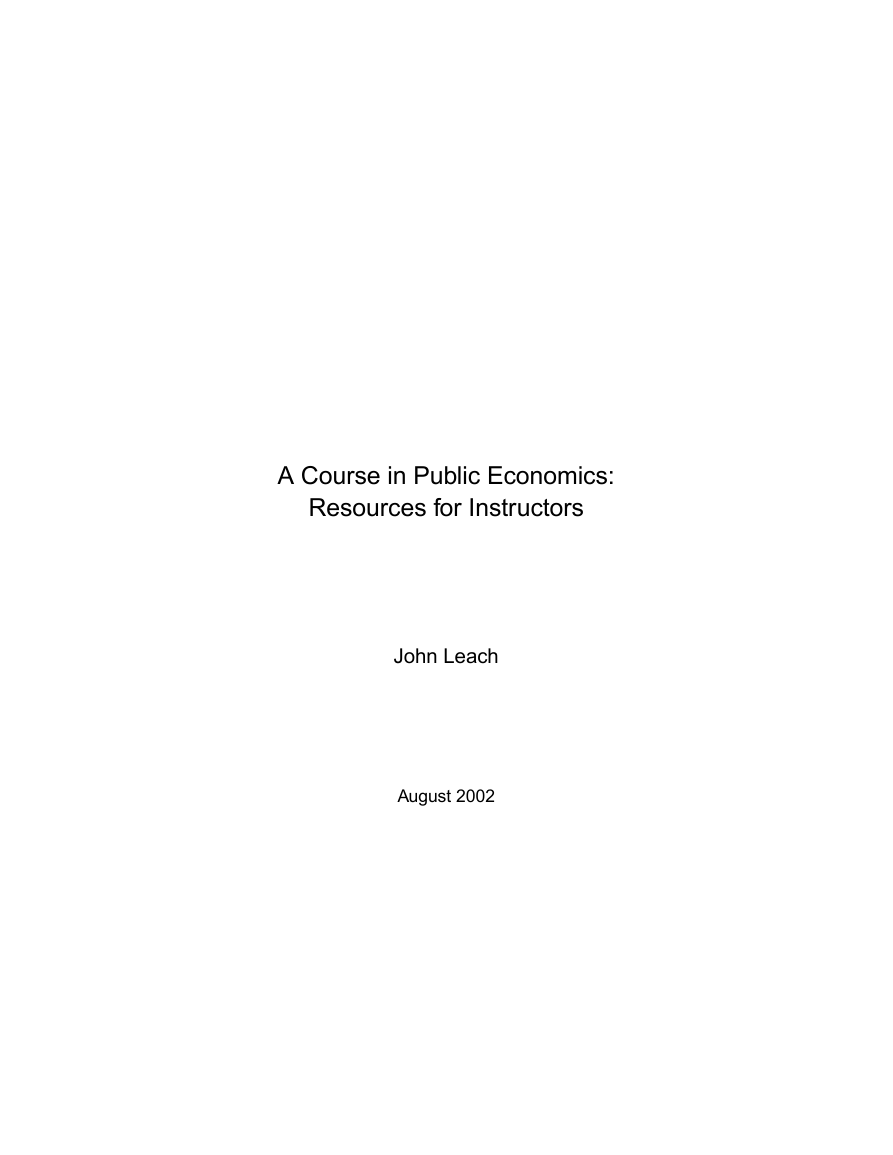

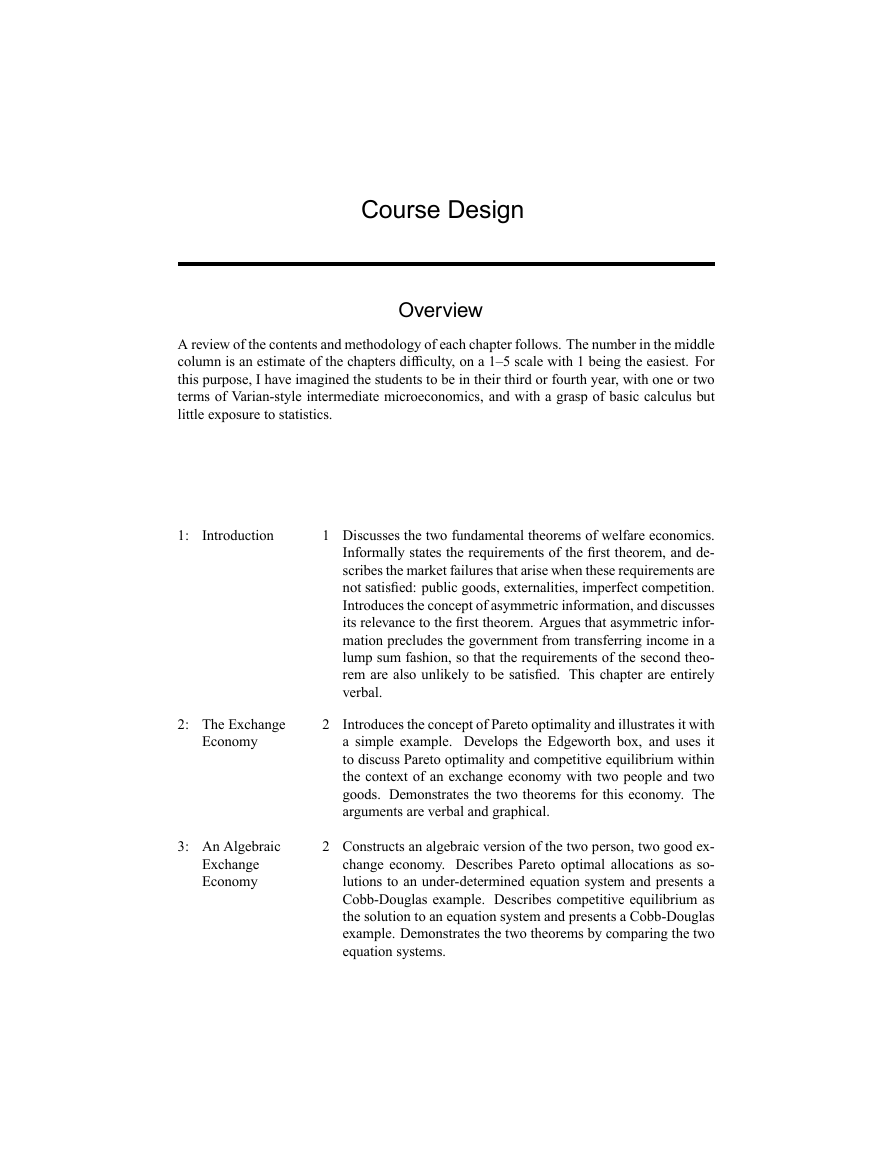
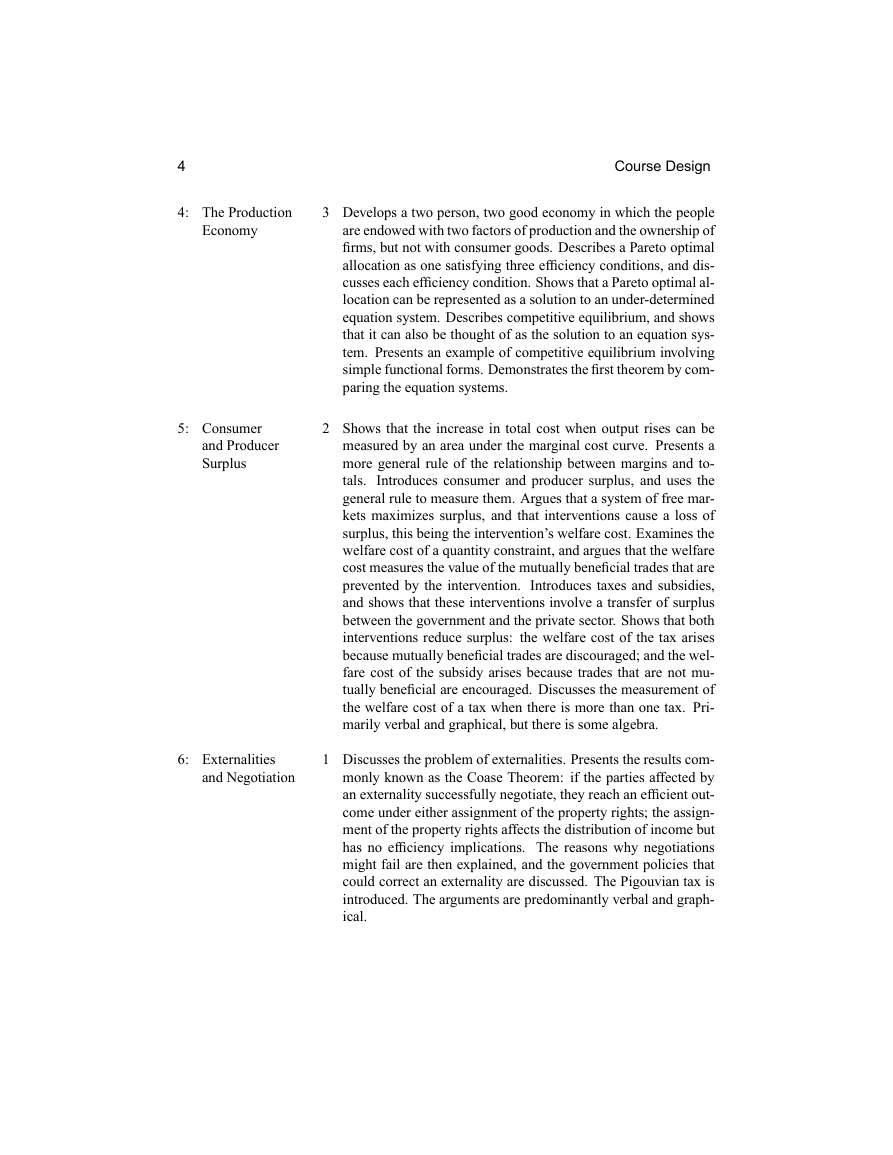
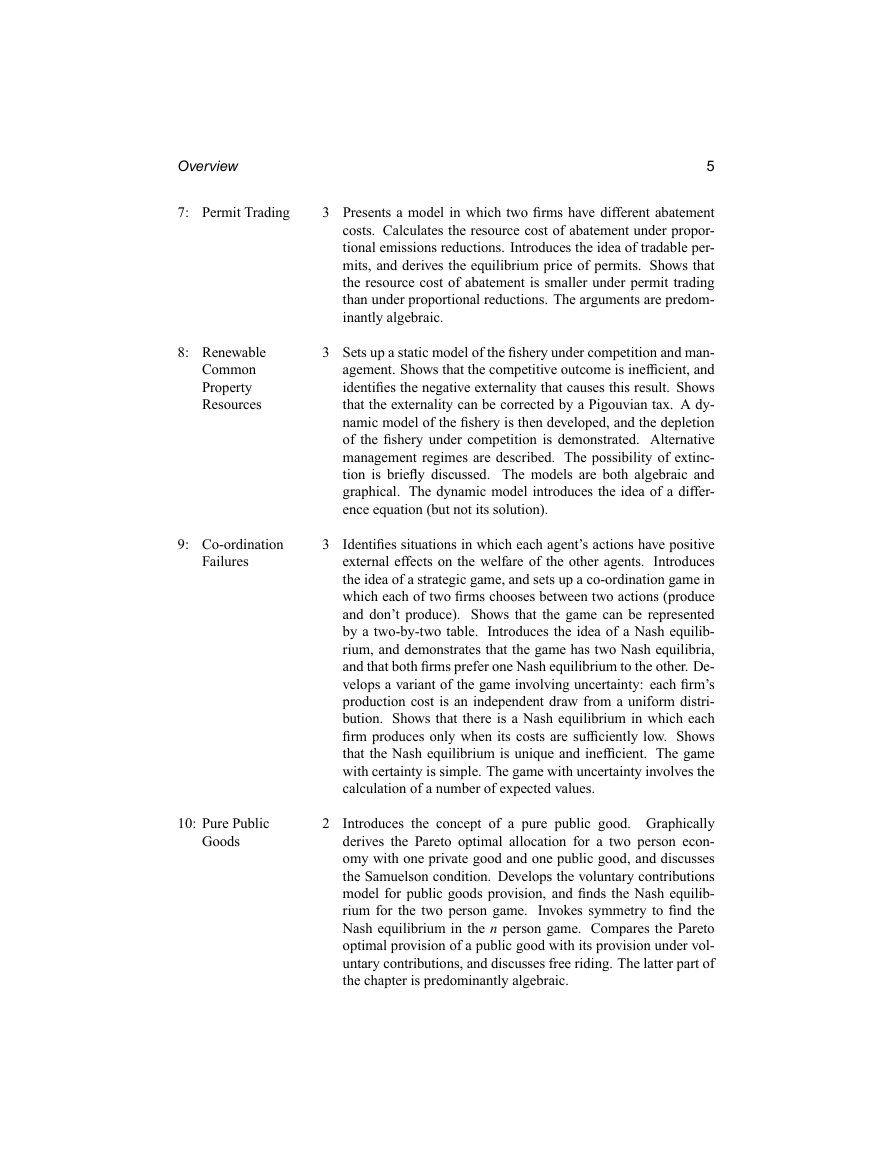
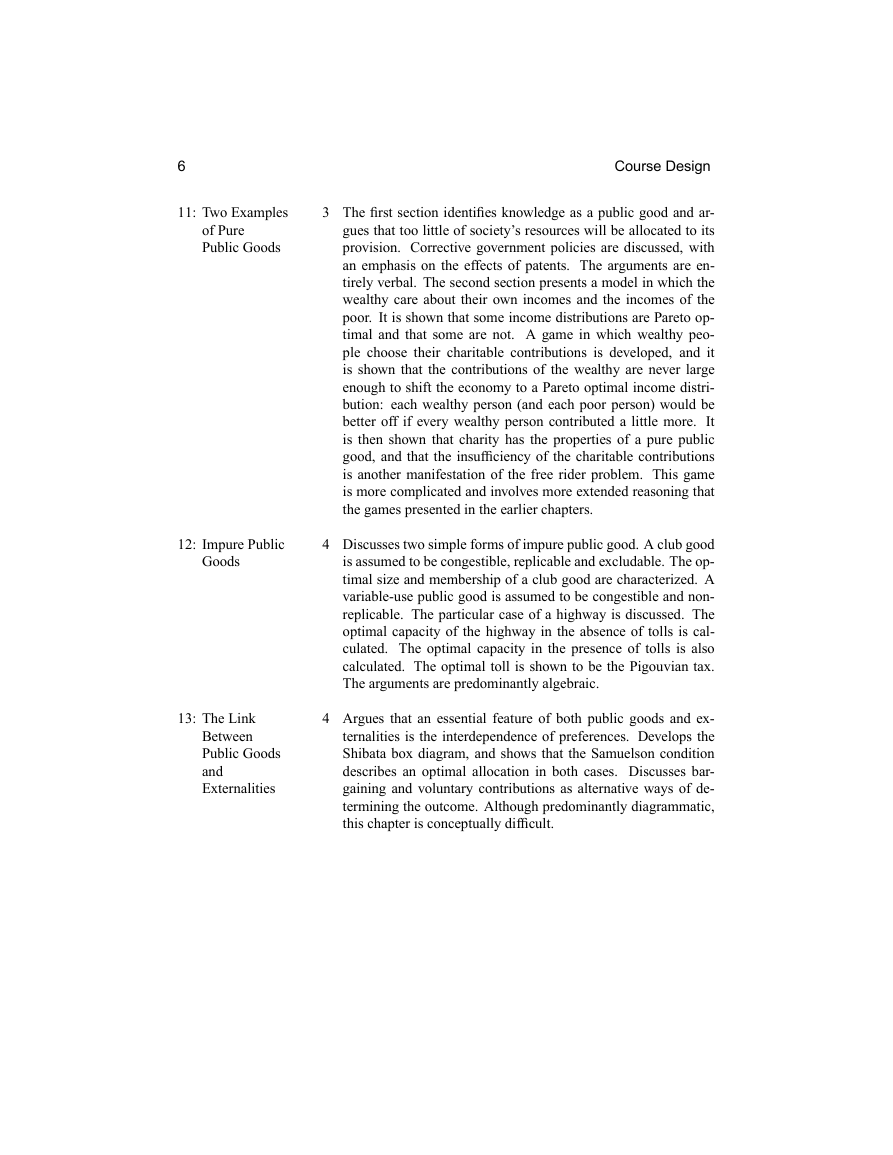
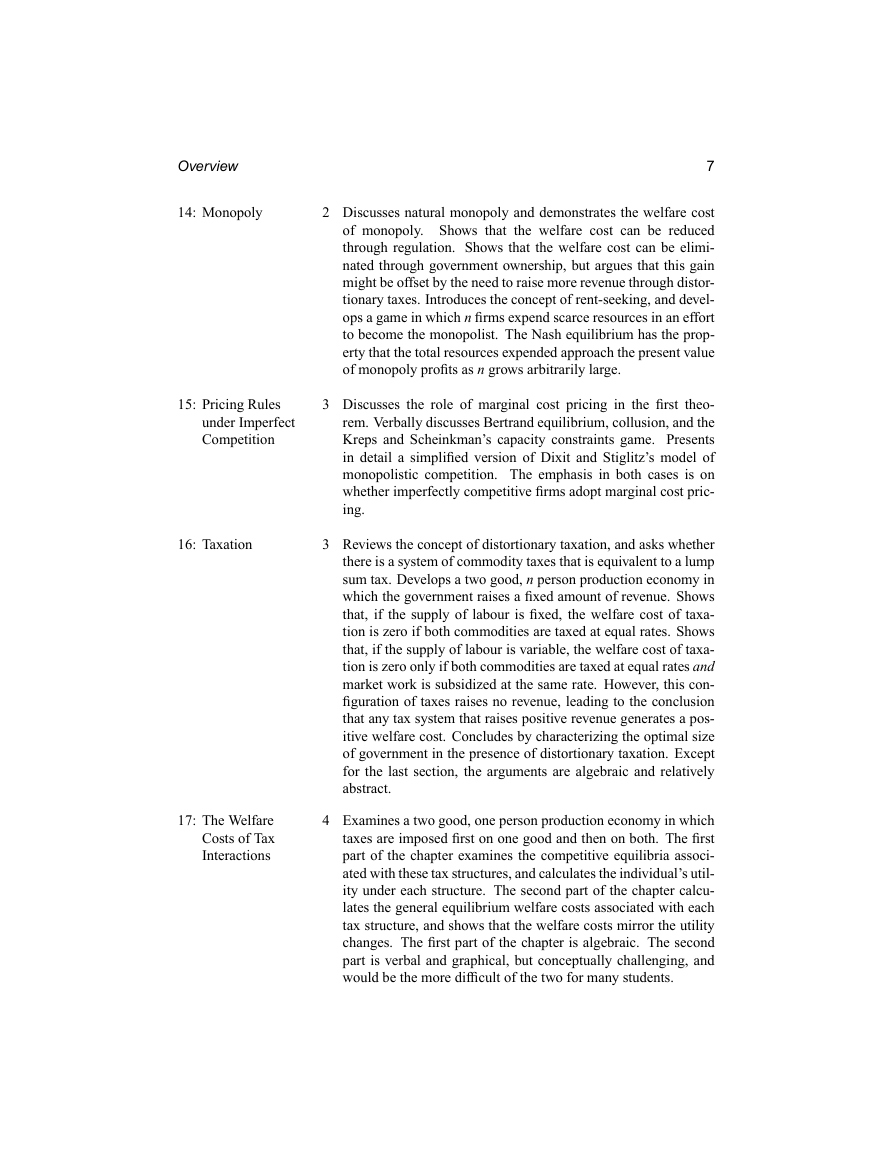
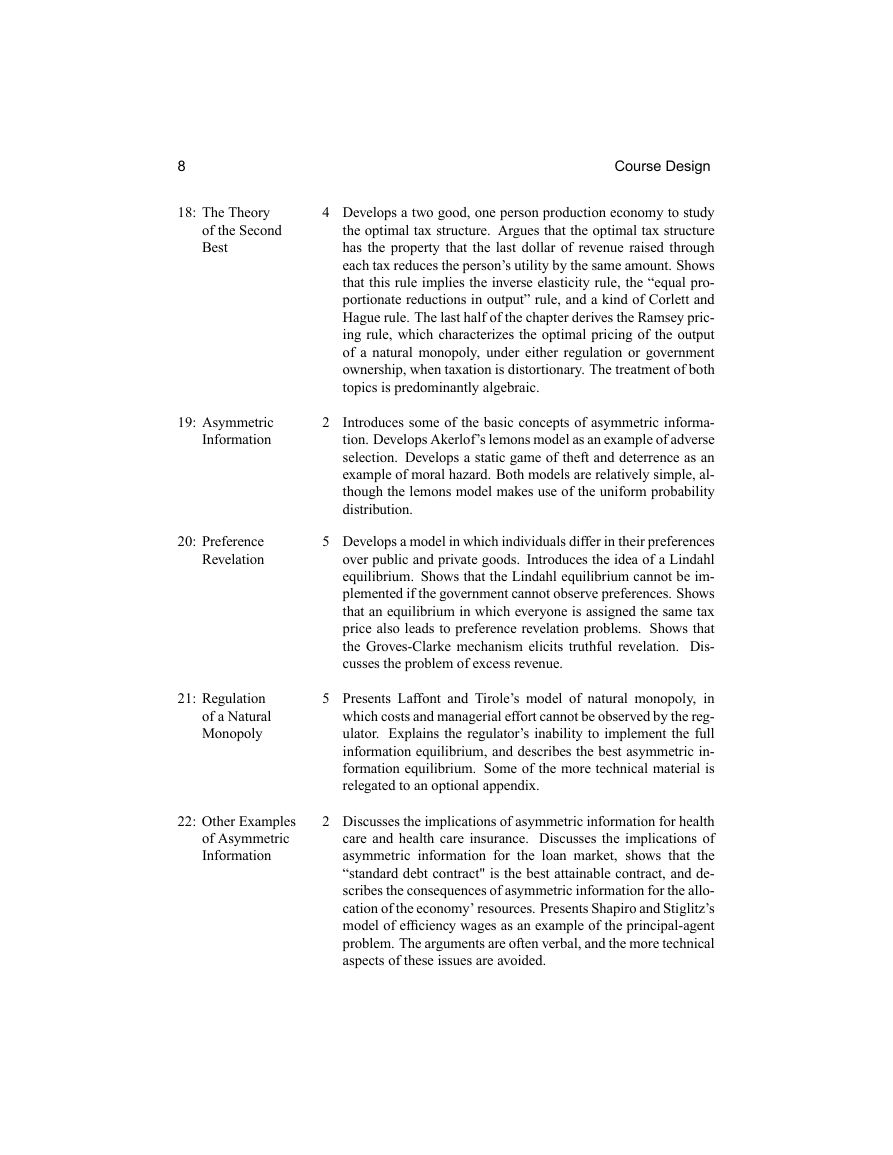








 2023年江西萍乡中考道德与法治真题及答案.doc
2023年江西萍乡中考道德与法治真题及答案.doc 2012年重庆南川中考生物真题及答案.doc
2012年重庆南川中考生物真题及答案.doc 2013年江西师范大学地理学综合及文艺理论基础考研真题.doc
2013年江西师范大学地理学综合及文艺理论基础考研真题.doc 2020年四川甘孜小升初语文真题及答案I卷.doc
2020年四川甘孜小升初语文真题及答案I卷.doc 2020年注册岩土工程师专业基础考试真题及答案.doc
2020年注册岩土工程师专业基础考试真题及答案.doc 2023-2024学年福建省厦门市九年级上学期数学月考试题及答案.doc
2023-2024学年福建省厦门市九年级上学期数学月考试题及答案.doc 2021-2022学年辽宁省沈阳市大东区九年级上学期语文期末试题及答案.doc
2021-2022学年辽宁省沈阳市大东区九年级上学期语文期末试题及答案.doc 2022-2023学年北京东城区初三第一学期物理期末试卷及答案.doc
2022-2023学年北京东城区初三第一学期物理期末试卷及答案.doc 2018上半年江西教师资格初中地理学科知识与教学能力真题及答案.doc
2018上半年江西教师资格初中地理学科知识与教学能力真题及答案.doc 2012年河北国家公务员申论考试真题及答案-省级.doc
2012年河北国家公务员申论考试真题及答案-省级.doc 2020-2021学年江苏省扬州市江都区邵樊片九年级上学期数学第一次质量检测试题及答案.doc
2020-2021学年江苏省扬州市江都区邵樊片九年级上学期数学第一次质量检测试题及答案.doc 2022下半年黑龙江教师资格证中学综合素质真题及答案.doc
2022下半年黑龙江教师资格证中学综合素质真题及答案.doc